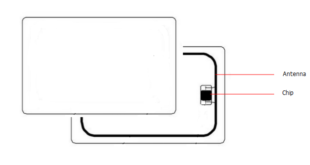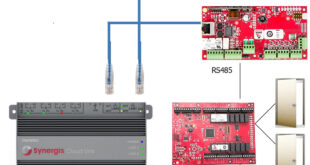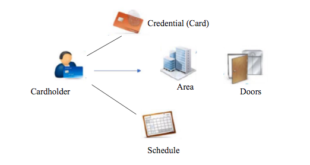A door is an entrance into a building, so the security of any building depends in part on its doors’ security.
Any security system should include a premise’s doors to prevent a break in.
Many equipment are designed to secure doors, in addition to configurations integrators can add to a system in order to increase the doors security, and to monitor its status by sending alarm on specific positions.
In this article, I am going to list the equipment a that secure a door and the alarms we configure on a door to monitor its status.
Door Equipment
- Reader
We swipe the card to identify the user, and then the access control grants or refuses access. All readers are built with buzzers and LEDs. LED colors and the buzzer sound communicate the door status.
- Door contact
It monitors the door. It says the door position, open or closed.
- LBM (Latch monitor position)
A door could be ajar (neither closed nor open). In this case, a door contact could be misled. In other words, if the contact is too close to its magnet, it sends the signal that a door is closed even if the latch is not locked. A door latch monitor position comes to confirm that a door is locked.
- Locking Equipment
Those equipment help to lock doors and keep them so. In addition, open them only for authorized people electrically. They are electrical strikes, electromagnets, electric mortise …etc
Read our posts :
Electrical locks and locking gears for more information
- Delayed egress anti panic
The Delayed Egress are designed to deter unauthorized exit, while it releases the door in an emergency. So it sounds when someone attempts to exit. If the person keeps pushing for 3 seconds (or a configurable duration) The alarm will continue to sound, and the lock will release after 15 seconds. Which provides the responsible party time to respond to the alarm.
Door alarms in access control systems
Access control sends an alarm to the monitoring screening in addition to sounding a siren. A siren could be a reader buzzer.
Door position:
Open or closed door position : Perimeter doors are supervised in anti burglar systems. As building security relies on its doors’ security, each door represents an alarm zone. As a result, They have to be closed in order to get the system ready to arm.
Access control and anti burglary systems can communicate. As a result, access control can refuse to unlock a door if a partition is on alarm. It also disarms it when swiping a reader by a specific cardholder.
- Door open too long alarm
We configure a door to be open for a certain time. Then, after access granted, the door is supposed to close after that time. Otherwise, it sends a door open too long alarm.
It warns when the door is prevented from closing. The system can also activate a siren sound to alert the security agent.
- Door forced alarm
The door opens on two conditions: request to exit (when the exit is free), and swiping of an authorized user’s card. If the door opens without those conditions, it sends an alarm on the monitoring screen and sounds a siren.
- Door unsecured alarm
An ajar door triggers an alarm and a buzzer sound as well. That prevents from blocking the door from locking.
- Delayed egress activation alarm (Alarm 3/15)
As exposed above, the Delayed Egress are designed to sound when someone attempts to exit. The alarm will continue to sound, but the door will remain locked for 15 seconds. An alarm on a delayed egress sounds a built-in siren, plus it sends an alarm status to a monitoring station.
Access control system can perform remote unlocking, remote dogging, and remote reset on delayed egress modules.
Camera call
When an access control is integrated with CCTV, we can perform camera calls. That means a door event triggers a camera to pop up to show the door. This makes it possible to assess the situation. Know the source of the event. Then dispatch the appropriate staff in order to intervene effectively.
You may also like our post :


